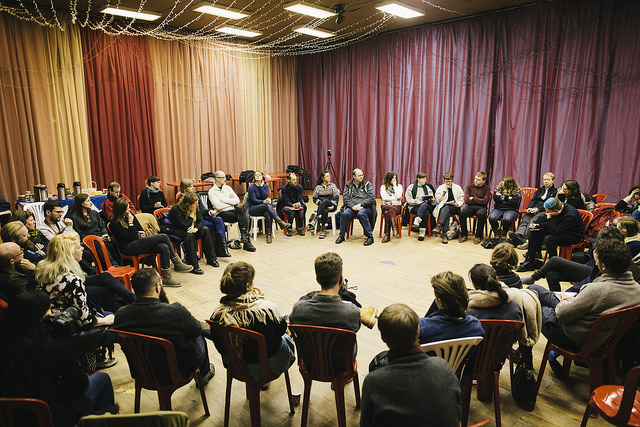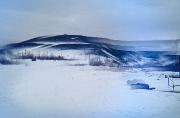 Photo by Michael Miller, Dark Ecology
Photo by Michael Miller, Dark Ecology
Organized by Arctic Encounters, Dark Ecology and Troms Fylkeskommune
(The event is free but please sign up here on facebook so we have an estimate)
VERDENSTEATRET 11-16
11.00-11.15: Two welcoming speeches, Vice Rector Kenneth Ruud & Arctic Encounters PI Britt Kramvig UiT The Arctic University of Norway
11:15-12:15 What is Dark Ecology and what has it become?
Dark Ecology is informed and inspired by amongst others Timothy Morton's idea of 'Dark Ecology', current discussions about ontologies in philosophy and anthropology, as well a by the landscape, the cultural and geopolitical situation in the Barents Region. Dark Ecology unfolded through research, the creation of new artworks, and three 'Journeys' with a public programme presented on both sides of the Norwegian-Russian border in 2014, 2015 and 2016.
In this panel curators Arie Altena (moderator), Hilde Methi, Annette Wolfsberger and artists Espen Sommer Eide & Margrethe Pettersen reflect on their involvement in the project, and how they approached the theme of 'Dark Ecology'
- See more at: https://uit.no/tavla/artikkel/466781/why_the_arctic_matters#sthash.8BYxym14.dpuf
11.00 Opening by Vice Rector of UIT Kenneth Ruud & Arctic Encounters PI professor Britt Kramvig UiT.
11:15-12:30 What is Dark Ecology and what has it become?
Dark Ecology is informed and inspired by amongst others Timothy Morton's idea of 'Dark Ecology', current discussions about ontologies in philosophy and anthropology, as well a by the landscape, the cultural and geopolitical situation in the Barents Region. Dark Ecology unfolded through research, the creation of new artworks, and three 'Journeys' with a public programme presented on both sides of the Norwegian-Russian border in 2014, 2015 and 2016.
In this panel curators Arie Altena (moderator), Hilde Methi and Annette Wolfsberger together with artists Espen Sommer Eide, Margrethe Pettersen who reflect on their involvement in the project, and how they approached the theme of 'Dark Ecology'. Screening of Signe Lidén's krysning/пересечение/conflux
11.00-11.15: Two welcoming speeches, Vice Rector Kenneth Ruud & Arctic Encounters PI Britt Kramvig UiT The Arctic University of Norway
11:15-12:15 What is Dark Ecology and what has it become?
Dark Ecology is informed and inspired by amongst others Timothy Morton's idea of 'Dark Ecology', current discussions about ontologies in philosophy and anthropology, as well a by the landscape, the cultural and geopolitical situation in the Barents Region. Dark Ecology unfolded through research, the creation of new artworks, and three 'Journeys' with a public programme presented on both sides of the Norwegian-Russian border in 2014, 2015 and 2016.
In this panel curators Arie Altena (moderator), Hilde Methi, Annette Wolfsberger and artists Espen Sommer Eide & Margrethe Pettersen reflect on their involvement in the project, and how they approached the theme of 'Dark Ecology'
- See more at: https://uit.no/tavla/artikkel/466781/why_the_arctic_matters#sthash.8BYxym14.dpuf
12.45-13.30 How and why do objects come to matter in the Arctic?
This panel explore the multiple way the material turn in the academic inspire scholars to rethink how they can stay loyal to objects or things like ruins, sites, stones, cities, people and nature. How can we craft academic stories where these entities can participating in ontological practices?
Moderator: Britt Kramvig with Helen Verran, Bjørnar Olsen, Tone Huse & Tora Pétursdóttirl
- See more at: https://uit.no/tavla/artikkel/466781/why_the_arctic_matters#sthash.8BYxym14.dpuf12.45-13.30 How and why do objects come to matter in the Arctic?
This panel explore the multiple way the material turn in the academic inspire scholars to rethink how they can stay loyal to objects or things like ruins, sites, stones, cities, people and nature. How can we craft academic stories where these entities can participating in ontological practices?
Moderator: Britt Kramvig with Helen Verran, Tone Huse & Tora Pétursdóttir
14.00-14.45 How does the ice edge come to matter?
This panel explores the biological, human and political aspects of the zone where the polar sea ice meets open water, amongst scientists explored as a marginal ice zone and between politicians discussed as ‘the ice edge’ in the Barents Sea/Arctic. What are the differences between the fixity of the ice edge as a single line used to map, plan or even ‘move’ and the zone as cyclical and lived environment?
Moderator: Hilde Methi with artist Jana Winderen post-doc Berit Kristoffersen (UiT), professor Bodil Bluhm (UiT) & professor Marit Reigstad, (UiT)
15.00 -16.00 How and why does the Arctic matter?
What kind of encounters are identified are central to knowledge and politics creation and development in the Arctic? Presenting extracts from the various Arctic Encounters project in dialogue with indigenous encounters in Russia, this session unpack ongoing research dialogues across the Arctic.
Moderator: Roger Norum with Lars Jensen, Katrin Anna Lund, Graham Huggan, Zoia Ravna
Kurant 19-21 with Timothy Morton & Jana Winderen
The evening ends with the Dark Ecology commissioned film Pasvikdalen (Jana Winderen)(19-20)
and a talk by philosopher Timothy Morton, who coined the idea of ‘Dark Ecology’ (in his book Ecology without Nature in 2010) and who is now launching his new book Dark Ecology - For a Future of Coexistence
About Winderen's sound installation Pasvikdalen: Drifting away from a state of stability, blurring acceleration, moving out of sight, but not out of mind. Invisible but audible, the consequences reveal themselves through the silence of species we have never heard. Jana Winderen’s new work Pasvikdalen is based on recordings made both above and under water close to the border between Norway and Russia.
About krysning/пересечение/conflux: Signe Lidén ‘sound-measured’ the border-zone during field trips in the surroundings of Kirkenes and Nikel. She walked across pastures, mountains and manmade landscapes such as military zones, harbours, mining areas and settlements, determining her route by shooting an arrow. By applying this unorthodox research method – a bow and arrow with recording devices and a weather balloon with a camera – she explored the coincidental in the ‘points of references’ on which knowledge systems and worldviews are based.
Signe Lidén's krysning/пересечение/conflux and Jana Winderen's Pasvikdalen are commissioned by Dark Ecology and Arctic Encounters.
Background:
We welcome artists, academics, and members of the public interested in exploring the ecology and politics of the Arctic. Its main aim is to bring creative artists and scholars together to engage with the contemporary realities of the Arctic region, using the agency of things as its lens for analysis. Our geological epoch is increasingly referred to today as theAnthropocene. This term asks what kinds of presuppositions organize our thinking about today's global environmental crisis, and how different ways of thinking might in turn open up new modes of action at a time when human beings make up the largest single force for change on the face of the Earth. The Anthropocene is also closely related to the so-called 'material turn', which is increasingly influential in academia as well as providing an inspiration for the current art scene. The idea that objects matter – ethically, politically, aesthetically – has becomes a new critical lens through which the Arctic can be contemplated. The agency of things, and their role in determining the geography and politics of the Arctic, are the main threads for this forum, which also acts as a kind of postscript to the Dark Ecology and Arctic Encounters projects as these are both soon coming to an end.
19.00-20.30 Thinking from the edge of the world (At Kurant)
Timothy Morton
Extracts from Dark Ecology artists’ encounters with the border area between Norway and Russia
Film by Signe Liden (20 min) , Jana (30 min) Passvikdalen.
- See more at: https://uit.no/tavla/artikkel/466781/why_the_arctic_matters#sthash.8BYxym14.dpuf